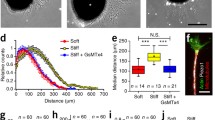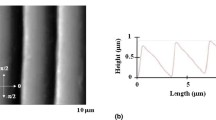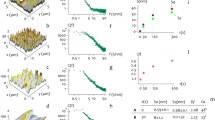Abstract
Nerve outgrowth in the develo** nervous system utilizes a variety of attractive and repulsive molecules found in the extracellular environment. In addition, physical cues may play an important regulatory role in determining directional outgrowth of nervous tissue. Here, by culturing nerve cells on filamentous surfaces and measuring directional growth, we tested the hypothesis that substrate curvature is sufficient to influence the directional outgrowth of nerve cells. We found that the mean direction of neurite outgrowth aligned with the direction of minimum principle curvature, and the spatial variance in outgrowth direction was directly related to the maximum principle curvature. As substrate size approached the size of an axon, adherent neurons extended processes that followed the direction of the long axis of the substrate similar to what occurs during development along pioneering axons and radial glial fibers. A simple Boltzmann model describing the interplay between adhesion and bending stiffness of the nerve process was found to be in close agreement with the data suggesting that cell stiffness and substrate curvature can act together in a manner that is sufficient to direct nerve outgrowth in the absence of contrasting molecular cues. The study highlights the potential importance of cellular level geometry as a fidelity-enhancing cue in the develo** and regenerating nervous system.
Similar content being viewed by others
References
Bate, C. M. Pioneer neurones in an insect embryo. Nature 260:54–56, 1976.
Bentley, D., and H. Keshishian. Pathfinding by peripheral pioneer neurons in grasshoppers. Science 218:1082–1088, 1982.
Bohner, M., T. A. Ring, N. Rapoport, and K. D. Caldwell. Fibrinogen adsorption by ps latex particles coated with various amounts of a peo/ppo/peo triblock copolymer. J. Biomater. Sci. Polym. Ed. 13:733–746, 2002.
Bottenstein, J. E., and G. H. Sato. Growth of a rat neuroblastoma cell line in serum-free supplemented medium. Proc. Natl. Acad. Sci. U.S.A. 76:514–517, 1979.
Buck, K. B., and J. Q. Zheng. Growth cone turning induced by direct local modification of microtubule dynamics. J. Neurosci. 22:9358–9367, 2002.
Carter, S. B. Principles of cell motility: The direction of cell movement and cancer invasion. Nature 208:1183–1187, 1965.
Challacombe, J. F., D. M. Snow, and P. C. Letourneau. Dynamic microtubule ends are required for growth cone turning to avoid an inhibitory guidance cue. J. Neurosci. 17:3085–3095, 1997.
Clark, P., S. Britland, and P. Connolly. Growth cone guidance and neuron morphology on micropatterned laminin surfaces. J. Cell Sci. 105:203–212, 1993.
Dunn, G. A., and A. F. Brown. Alignment of fibroblasts on grooved surfaces described by a simple geometric transformation. J. Cell Sci. 83:313–340, 1986.
Gittes, F., B. Mickey, J. Nettleton, and J. Howard. Flexural rigidity of microtubules and actin filaments measured from thermal fluctuations in shape. J. Cell Biol. 120:923–934, 1993.
Goschel, U., F. H. M. Swartjes, G. W. M. Peters, and H. E. H. Meijer. Crystallization in isotactic polypropylene melts during contraction flow: Time-resolved synchrotron waxd studies. Polymer 41:1541–1550, 2000.
Harrison, R. G. On the stereotropism of embryonic cells. Science 34:279–281, 1911.
Ho, R. K., and C. S. Goodman. Peripheral pathways are pioneered by an array of central and peripheral neurones in grasshopper embryos. Nature 297:404–406, 1982.
Katz, M. J. How straight do axons grow? J. Neurosci. 5:589–595, 1985.
Lander, A. D. Molecules that make axons grow. Mol. Neurobiol. 1:213–245, 1987.
Letourneau, P. C. Possible roles for cell-to-substratum adhesion in neuronal morphogenesis. Dev. Biol. 44:77–91, 1975.
Li, J., J. Carlsson, S. Huang, and K. D. Caldwell. Adsorption of poly(ethylene oxide)-containing block copolymers. In: Hydrophilic Polymers: Performance with Environmental Acceptance, edited by J. E. Glass. Washington, DC: American Chemical Society, 1996, pp. 61–78.
Manthorpe, M., E. Engvall, E. Ruoslahti, F. M. Longo, G. E. Davis, and S. Varon. Laminin promotes neuritic regeneration from cultured peripheral and central neurons. J. Cell Biol. 97:1882–1890, 1983.
Nguyen, Q. T., J. R. Sanes, and J. W. Lichtman. Pre-existing pathways promote precise projection patterns. Nat. Neurosci. 5:861–867, 2002.
Oakley, C., and D. M. Brunette. The sequence of alignment of microtubules, focal contacts and actin filaments in fibroblasts spreading on smooth and grooved titanium substrata. J. Cell Sci. 106:343–354, 1993.
Rakic, P. Specification of cerebral cortical areas. Science 241:170–176, 1988.
Rogers, S. L., K. J. Edson, P. C. Letourneau, and S. C. McLoon. Distribution of laminin in the develo** peripheral nervous system of the chick. Dev. Biol. 113:429–435, 1986.
Salonen, V., J. Peltonen, M. Roytta, and I. Virtanen. Laminin in traumatized peripheral nerve: Basement membrane changes during degeneration and regeneration. J. Neurocytol. 16:713–720, 1987.
Silver, J., and R. L. Sidman. A mechanism for the guidance and topographic patterning of retinal ganglion cell axons. J. Comp. Neurol. 189:101–111, 1980.
Singer, M., R. H. Nordlander, and M. Egar. Axonal guidance during embryogenesis and regeneration in the spinal cord of the newt: The blueprint hypothesis of neuronal pathway patterning. J. Comp. Neurol. 185:1–21, 1979.
Sommer, I., and M. Schachner. Monoclonal antibodies (o1 to o4) to oligodendrocyte cell surfaces: An immunocytological study in the central nervous system. Dev. Biol. 83:311–327, 1981.
Tanaka, E. M., and M. W. Kirschner. Microtubule behavior in the growth cones of living neurons during axon elongation. J. Cell Biol. 115:345–363, 1991.
Van Vactor, D. Adhesion, and signaling in axonal fasciculation. Curr. Opin. Neurobiol. 8:80–86, 1998.
Weiss, P. Nerve patterns: The mechanics of nerve growth. Growth, Third Growth Symp. 5:163–203, 1941.
Yu, W., and P. W. Baas. Changes in microtubule number and length during axon differentiation. J. Neurosci. 14:2818–2829, 1994.
Zhou, F. Q., C. M. Waterman-Storer, and C. S. Cohan. Focal loss of actin bundles causes microtubule redistribution and growth cone turning. J. Cell Biol. 157:839–849, 2002.
Author information
Authors and Affiliations
Corresponding author
Rights and permissions
About this article
Cite this article
Smeal, R.M., Rabbitt, R., Biran, R. et al. Substrate Curvature Influences the Direction of Nerve Outgrowth. Ann Biomed Eng 33, 376–382 (2005). https://doi.org/10.1007/s10439-005-1740-z
Received:
Accepted:
Issue Date:
DOI: https://doi.org/10.1007/s10439-005-1740-z




